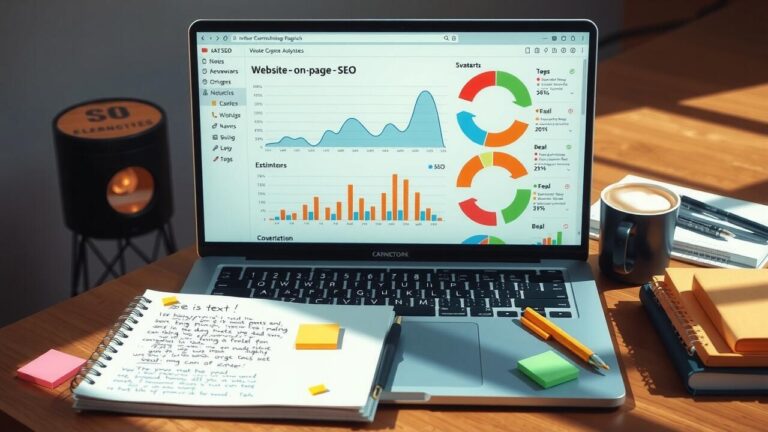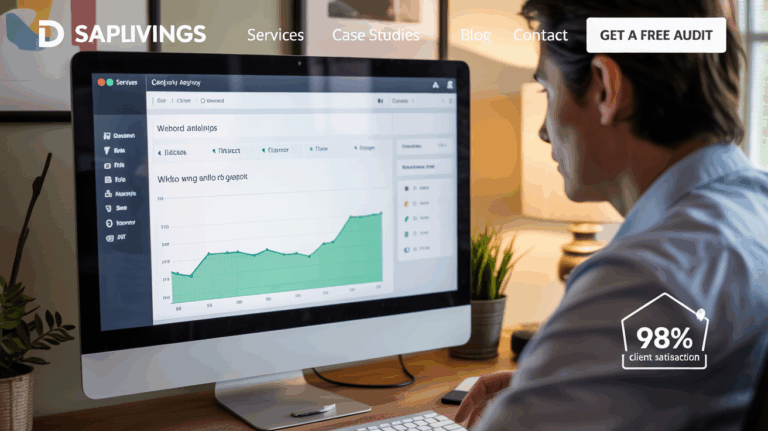SEO vs. SEM: What’s the Best Strategy for Your Business in 2025?
The Role of Keywords in SEO
Keywords, those pivotal cornerstones of search engine optimization, dance at the intersection of content creation and user engagement. But oh! Selecting the right ones is no casual stroll in the park; it demands a deep dive into the labyrinth of user intent and search volume metrics. Enter keyword planners—those magical tools that illuminate terms resonating with target audiences, all while bolstering a website’s visibility on the vast expanse of search engines.
But here’s where it gets intriguing: the magic lies not just in choosing keywords but in their strategic placement throughout your website’s tapestry. They must harmonize perfectly with what users are actively searching for.
Now, let’s talk about balance—a delicate waltz between keyword density and content quality. Overdoing it can lead to that dreaded fate known as keyword stuffing, which could earn you an unwelcome slap on the wrist from search engines. And don’t overlook long-tail keywords! These gems can tap into niche markets while weaving contextually rich narratives that cater to specific audience desires.
By artfully threading relevant keywords into high-quality content, businesses can craft a more immersive user experience—and guess what? This savvy strategy doesn’t just engage; it also nudges those precious search rankings ever upward!
Identifying Effective Keywords for Optimization
In the intricate dance of digital visibility, selecting the right keywords emerges as a pivotal move—a game-changer in the vast arena of search engine results. It’s not merely about picking words; it’s about delving deep into the psyche of target audiences and unraveling their elusive search behaviors. Enter powerful allies like Google Keyword Planner and SEMrush—tools that don’t just whisper insights but roar them, revealing secrets hidden in search volume, competition metrics, and emerging trends.
But wait! The landscape is also dotted with competitors whose keyword strategies can unveil treasure troves of opportunity waiting to be exploited. And let’s not overlook the understated charm of long-tail keywords—they’re like secret passageways leading directly to niche traffic that craves your offerings while sidestepping intense competition often found in broader terms.
Now, once you’ve amassed this tantalizing collection of potential keywords, it’s time to scrutinize their relevance with a discerning eye. These effective gems must resonate harmoniously with what your business presents—creating an authentic user experience that’s too good to resist. Fine-tuning this list based on intent and contextual suitability isn’t just beneficial; it’s essential for sparking engagement that captivates users.
Yet remember: this isn’t a one-and-done scenario! The digital realm shifts constantly, so regularly revisiting and refreshing your keyword strategies is crucial—like keeping your finger on the pulse of changing consumer interests and competitive dynamics—to maintain that coveted edge in optimization efforts. So gear up for an ongoing quest where adaptability reigns supreme!
| Keyword Type | Description | Tools for Research | Estimated Search Volume |
|---|---|---|---|
| Short-tail Keywords | General keywords that attract high traffic but have high competition. | Google Keyword Planner, Ahrefs | 10,000+ |
| Long-tail Keywords | Specific phrases that target niche audiences and have lower competition. | SEMrush, Ubersuggest | 1,000 – 5,000 |
| Competitor Keywords | Keywords that your competitors rank for, offering insights into market opportunities. | SpyFu, Moz | Varies by competitor |
| Branded Keywords | Keywords including your brand name, typically indicating user intent to engage. | Google Trends, KeywordTool.io | 5,000+ |
The Impact of Content Quality
Top-notch content is the bedrock of both SEO and SEM strategies, a vital element that can’t be overlooked. It does more than just capture attention; it ignites interest, inspiring users to spread the word across social media like wildfire. Search engines—those ever-watchful gatekeepers—favor content that truly delivers value, intertwining it with relevance and user experience in a delicate dance. This relentless pursuit of quality translates into better search rankings, ultimately funneling organic traffic straight to your website.
But wait! The magic doesn’t stop there; engaging and informative content is equally pivotal in the realm of paid advertising. When users stumble upon meticulously designed ads brimming with worthwhile information, their curiosity often compels them to click—and convert! Moreover, maintaining a consistent standard of excellence in your content cultivates brand authority, weaving trust and loyalty into the very fabric of customer relationships. Therefore, pouring resources into superior content isn’t just smart—it’s an investment poised to reap substantial rewards in visibility and engagement with customers galore!
Content Strategies for SEO and SEM Success
Crafting content that truly resonates with your target audience? Oh, it’s absolutely vital for nailing both SEO and SEM success! When it comes to SEO, the spotlight shines on churning out high-quality, informative pieces—think articles that weave in relevant keywords as if they belong there. Engaging blog posts that pull readers in, comprehensive guides brimming with insights, and eye-catching infographics can not only elevate user experience but also give those search engine rankings a nice little boost. And let’s not forget: keeping a steady publishing rhythm sends a clear message to search engines—your site is alive and kicking! This consistency works wonders for your organic visibility.
Now, flip the coin over to SEM. Here, the game shifts dramatically; it’s all about crafting irresistible ad copy designed to grab attention and spark clicks like fireworks on the Fourth of July! You’ve got to dive deep into understanding who your audience is—what makes them tick—and tailor messages that hit right at their pain points. A/B testing? Absolutely essential! It’s where businesses can fine-tune their strategies based on what actually works according to performance metrics. Both approaches thrive when infused with those all-important call-to-action elements—after all, we want users engaged and eager to convert! Higher conversion rates are just around the corner if you play it right!
Measuring Success
To truly grasp the essence of success in digital marketing, one must dive deep into a labyrinth of metrics that resonate with overarching business objectives. For those companies laser-focused on SEO, key players emerge: organic traffic, keyword rankings—all intertwined with user engagement statistics like bounce rate and average session duration. These vital signs offer glimpses into how a website dances within the search engine spotlight and how visitors engage—or disengage—with its content.
Now shift your gaze to SEM; here, critical performance indicators (KPIs) take center stage—think click-through rates (CTR), conversion rates, and cost-per-click (CPC). Each number whispers secrets about campaign efficacy and return on investment.
But here’s where it gets interesting: by consistently tracking and dissecting these figures, businesses can sculpt their strategies over time—a process akin to fine-tuning a masterpiece. Analytics tools serve as magnifying glasses that reveal intricate details across both SEO and SEM realms. This treasure trove of information empowers marketers to make savvy decisions about resource allocation—understanding which campaigns spark the most engagement or conversions becomes paramount in this fast-paced digital arena.
And let’s not forget—the regular review of these performance indicators isn’t just routine; it’s essential for maintaining an edge amid the swirling currents of change in today’s dynamic landscape!
Tracking Performance Indicators for Both Strategies
Keeping a keen eye on performance indicators is absolutely vital when it comes to assessing how well SEO and SEM strategies are doing their job. Picture this: for SEO, you’re honing in on metrics like organic traffic, keyword rankings, and bounce rates—each of these nuggets offers a glimpse into user engagement and the all-important visibility of your website within the vast sea of search engine results. And let’s not overlook local search performance; that data can be a goldmine for businesses aiming to capture specific geographic markets.
Now, swing over to SEM where the focus shifts slightly—here, pivotal performance indicators such as click-through rates (CTR), conversion rates, and cost per acquisition (CPA) come into play. Delving into these metrics allows businesses to measure the pulse of their paid advertising efforts with precision. But here’s the kicker: both approaches demand relentless evaluation to stay in sync with broader marketing goals. By continuously tracking these signals, companies can sharpen their tactics on-the-fly and pivot swiftly in response to market dynamics!
- Regularly assess organic traffic growth over time to identify trends and areas for improvement.
- Monitor keyword rankings to track the effectiveness of your optimization efforts.
- Analyze bounce rates to gauge the level of user engagement and content relevance.
- Evaluate local search performance to tailor strategies for specific geographic audiences.
- Track click-through rates (CTR) to understand how well ad copy and visuals resonate with target audiences.
- Measure conversion rates to determine the effectiveness of landing pages and overall campaign success.
- Calculate cost per acquisition (CPA) to manage budget and optimize return on investment (ROI).
Evolving Trends in 2025
The landscape of digital marketing is on the brink of a seismic shift, fueled by emerging technologies and the ever-evolving whims of consumer behavior. Picture this: artificial intelligence weaving its way into the very fabric of SEO and SEM, supercharging targeting and personalization like never before. As search engines evolve into complex entities with an uncanny ability to decipher user intent, businesses find themselves at a crossroads—mastering algorithms that now favor relevance and context over mere keywords.
Fast forward to 2025, where voice search reigns supreme while mobile optimization takes center stage. Our mounting dependence on smart devices nudges marketers towards embracing conversational keywords alongside robust local SEO strategies. But wait—there’s more! Visual search capabilities are poised for a meteoric rise; brands must scramble to invest in striking images and captivating videos to stay afloat in this competitive sea. The key? A comprehensive strategy that interlaces these dynamic trends can dramatically amplify online visibility and user engagement, making it absolutely essential for companies to remain nimble in their marketing maneuvers.
Predictions for SEO and SEM Landscape
The ever-deepening integration of artificial intelligence into search algorithms is poised to revolutionize SEO and SEM strategies in ways we can barely fathom. As AI evolves, becoming increasingly skilled at deciphering user intent and context, businesses will find themselves compelled to elevate their game—prioritizing not just any content, but high-quality, relevant material that resonates with these technological leaps. This emerging trend isn’t merely a call for technical optimization; it’s a clarion call for organizations to cultivate profound engagement with their audiences through personalized and genuinely meaningful interactions.
Furthermore, as we gaze toward 2025, voice search and mobile optimization are set to reign supreme in this digital arena. The surge of smart speakers and voice-activated devices creates an imperative: businesses must recalibrate their keyword strategies to embrace the fluidity of natural language patterns. This transition demands a sweeping focus on local SEO tactics while honing in on delivering concise yet informative answers to everyday queries. Companies that remain vigilant and proactive amidst these shifting tides will find themselves uniquely positioned to harness the full potential of both organic and paid search strategies with exceptional efficacy.
Making the Right Choice for Your Business
Navigating the crossroads of SEO and SEM is no small feat; it demands a keen grasp of your business aspirations and the audience you aim to captivate. Picture this: SEO, a slow-burning ember, nurturing long-term growth with an almost zen-like patience. It’s about crafting content that sings in harmony with keyword optimization—a strategic ballet where every move counts.
Now flip the coin! Enter SEM, bursting forth like fireworks on the Fourth of July—offering instant visibility that can be a game-changer for those urgent promotions or exhilarating new product debuts.
But hold up! Before diving headfirst into either approach, let’s talk dollars and cents—the budget matters immensely here! SEO tends to play nice with lower ongoing costs but requires relentless dedication in terms of time and effort—think marathon runner rather than sprinter. In contrast, SEM often comes with a steeper price tag due to bidding wars over keywords and managing ad campaigns like a conductor leading an orchestra through complex pieces.
So what’s the bottom line? Businesses must juggle their financial capabilities against their timelines for growth to figure out which path aligns harmoniously with their ambitions. Choose wisely!
Factors to Consider When Choosing Between SEO and SEM
When it comes to charting the best course for your business, a host of critical factors clamors for your attention. First and foremost, let’s talk about the budget—oh yes, that ever-pressing financial constraint! The amount you’re willing to allocate toward marketing can dramatically sway your choice between SEO and SEM. Picture this: SEO often boasts lower long-term costs since it zeroes in on organic search results and meticulously crafted content optimization. It’s like planting a seed and nurturing it over time until it blossoms into something magnificent. On the flip side, we have SEM—a realm where substantial upfront investments are par for the course as paid advertising campaigns promise immediate visibility but come with an ongoing funding requirement that could leave your wallet feeling quite light.
But wait! There’s more—the very essence of your business coupled with its unique aspirations plays a monumental role in this decision-making dance. Brands chasing long-lasting growth and striving for a solid digital footprint may find themselves leaning heavily toward robust SEO strategies—think of them as building a sturdy foundation for future endeavors. On the other hand, if you’re looking to spark an uptick in traffic or promote something urgent—a flash sale perhaps?—then SEM might just be your golden ticket. And don’t forget about diving deep into audience behavior along with peering at the competitive landscape; these elements will further illuminate which strategy aligns harmoniously with what you aim to achieve in the whirlwind world of online commerce!
Conclusion
The choice between SEO and SEM is a nuanced dance, one that pivots on the unique objectives of your business and the resources at your disposal. Pouring time into SEO could reap rewards in the form of organic traffic—think slow burn, long-term gains—while SEM catapults you to immediate visibility with results you can measure almost instantaneously. It’s imperative for businesses to pause, reflect, and evaluate their current landscape alongside their aspirations to pinpoint which strategy resonates most harmoniously with their marketing vision.
As we navigate this ever-changing digital terrain, keeping an ear to the ground about new trends and best practices in both realms becomes essential. A hybrid approach might just be the golden ticket—a clever blend harnessing the strengths of both strategies—to empower businesses seeking a dynamic boost in their online presence. Organizations must cultivate agility and adaptability, poised for swift shifts as industry currents ebb and flow alongside evolving consumer behaviors.
FAQS
What’s the primary distinction between SEO and SEM?
Ah, the crux of it all! SEO, or Search Engine Optimization, is like fine-tuning your website’s content to ascend those coveted organic search rankings. In contrast, SEM—Search Engine Marketing—is the realm of paid advertising that catapults your visibility in search engine results. Two sides of a coin, each with its own flair!
How do I figure out which strategy suits my business best?
To navigate this decision maze between SEO and SEM, ponder over several key elements: your budgetary constraints, the audience you wish to captivate, how fierce your competition is lurking around every digital corner, and just how urgently you need to reach those marketing milestones. A thorough examination of these factors will illuminate which path aligns seamlessly with your business goals.
Are keywords vital for both SEO and SEM?
Absolutely! Keywords are the lifeblood coursing through both strategies’ veins. In the universe of SEO, they’re instrumental in shaping content that resonates organically; meanwhile in SEM’s dynamic landscape, they become essential tools for crafting laser-focused ad campaigns aimed at specific inquiries.
How can I gauge whether my efforts in SEO and SEM are hitting their mark?
The measurement of success unfurls across a tapestry woven with various metrics—think organic traffic spikes, conversion rates dancing upward, click-through rates (CTR) that catch the eye like a siren song, and return on investment (ROI) reflecting back at you from financial shores. Keeping tabs on these performance indicators allows you to dissect just how effective your strategies truly are.
What emerging trends should I keep an eye on for 2025 regarding SEO and SEM?
As we gaze into 2025’s crystal ball—be prepared for trends such as a burgeoning focus on voice search optimization echoing through our devices; AI-driven content creation redefining creativity itself; and an intriguing pivot toward user experience metrics reshaping engagement norms. Being attuned to these shifts ensures you’re not merely reacting but proactively evolving your strategies!







